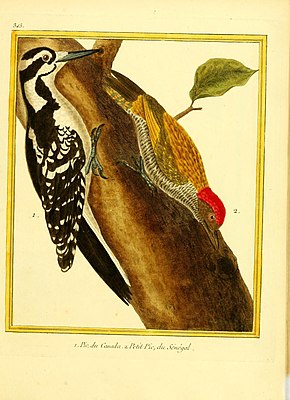Golden-mantled woodpecker
| Golden-mantled woodpecker | ||||||||||
|---|---|---|---|---|---|---|---|---|---|---|

Golden-mantled woodpecker ( Campethera maculosa ), |
||||||||||
| Systematics | ||||||||||
|
||||||||||
| Scientific name | ||||||||||
| Campethera maculosa | ||||||||||
| ( Valenciennes , 1826) |
The Golden-mantled Woodpecker ( Campethera maculosa ) is a species of bird from the family of woodpeckers (Picidae). The relatively small distribution area of the species includes the coastal area of West Africa from west Guinea-Bissau to the east to central Ghana . The golden-mantled woodpecker inhabits more open forest habitats such as the edges of the tropical rainforest and secondary forest , clearings with secondary vegetation and dead trees, and landscapes in which forest and scrubland alternate. As far as is known, the diet consists of ants , mainly from species of the Crematogaster genus .
The species is considered not rare. Since it prefers more open forest areas, it apparently benefits from the clearing of the forest and from clearing and the population appears to be increasing. The gold-coated woodpecker is therefore classified by the IUCN as safe ("least concern").
description
Gold-mantled woodpeckers are very small woodpeckers with a short beak that is quite broad at the base. The body length is about 16 cm, the weight of a bird was 54 g; they are as big as a small woodpecker , but almost twice as heavy. The species shows a clear sexual dimorphism in terms of coloration .
In males, the entire upper side, including the upper wing-coverts and the upper-tail-coverts, is yellowish green to bronze green, the rump is weakly banded. Occasionally there will be some white spots on the upper back and some individuals will show traces of red on the top. The wings are brown with light beige banding, which is widest on the inside flags . The steering feathers are blackish on top with indistinct yellow keels, the outer steering feathers are green. The basic color of the underside of the fuselage changes from the light beige throat into a greenish white shade below the breast, the entire underside of the fuselage is banded in strong dark olive. The under wing coverts are light yellowish white and unmarked or have only a few indistinct and interrupted bands. The under tail is blackish with a shade of yellow.
The fletching of the forehead and top of the head is black with red tips, the back of the head is not very plain red. The rest of the head, neck, chin and throat are dense brown spots on a beige-white background.
The bill is dark olive-green or blackish, the lower bill has a bluish or olive tone. Legs and toes are olive gray or greenish. The iris is brown or pinkish brown.
The female has no red head. The forehead and upper head feathers are spotted on an olive-black background, the back of the head on a deep olive background with beige spots. The intraspecies variability is low and no subspecies are recognized.
Vocalizations
The most frequent call is an even series of three to four ascending sounds such as "teeäi teeäi ..." . In addition, a possibly aggressively tinted "teerweet-teerweet ..." is known.
distribution and habitat
The relatively small distribution area of the species includes the coastal area of West Africa from western Guinea-Bissau to the east to central Ghana . Inland, the area only extends to the area south of Mount Nimba . The size of the total distribution area is estimated at 430,000 km².
The golden-mantled woodpecker inhabits more open forest habitats such as the edges of the tropical rainforest and secondary forest , clearings with secondary vegetation and dead trees, and landscapes in which forest and scrubland alternate. The animals come from the flatlands to over 1000 m altitude.
Way of life
Almost nothing is known about the way of life of the golden-coated woodpecker. The animals are not shy and inconspicuous and move around in no great hurry. As far as is known, the diet consists of ants , mainly from species of the Crematogaster genus . Breeding activity was observed in Senegambia in August, possibly March and April as well.
Existence and endangerment
Information on the size of the world population is not available. The species is considered not rare. Since it prefers more open forest areas, it apparently benefits from the clearing of the forest and from clearing and the population appears to be increasing. The gold-coated woodpecker is therefore classified by the IUCN as safe ("least concern").
swell
Individual evidence
- ↑ The Goldmantle Woodpecker at BirdLife International (Online, accessed April 21, 2011)
literature
- Hans Winkler , David A. Christie and David Nurney: Woodpeckers. A Guide to the Woodpeckers, Piculets, and Wrynecks of the World. Pica Press, Robertsbridge 1995, ISBN 0-395-72043-5 , pp. 74-75 and 233.
Web links
- Campethera maculosa in the endangered Red List species the IUCN 2010. Posted by: BirdLife International, 2009. Accessed April 21, 2011th
Other web links
- Videos, photos and sound recordings of Campethera maculosa in the Internet Bird Collection